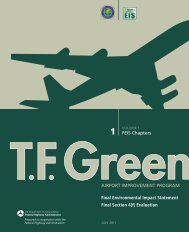Ch 2 Precision Approach Feasibility - PVD
Ch 2 Precision Approach Feasibility - PVD
Ch 2 Precision Approach Feasibility - PVD
Create successful ePaper yourself
Turn your PDF publications into a flip-book with our unique Google optimized e-Paper software.
North Central State Airport<br />
<strong>Ch</strong>apter 2 – <strong>Precision</strong> <strong>Approach</strong> <strong>Feasibility</strong><br />
Airport Master Plan<br />
FINAL<br />
Several factors determine the minimums for an instrument approach. Implementing a LPV approach is no<br />
different. The two driving factors are the obstacles in the environment surrounding the airport and the<br />
airport infrastructure. The Height Above Touchdown (HAT) of the approach is based solely on the obstacles<br />
(natural or manmade) and how close they come to penetrating the glide slope obstacle clearance surfaces.<br />
Often these are beyond the control of airport management to clear and will affect the HAT for the approach.<br />
The visibility requirement for the approach is partly dependent upon the airfield infrastructure.<br />
Achieving the lowest visibility requires an obstacle clear surface and, as discussed in Section 2.2.2, the<br />
appropriate airport infrastructure to support the approach. The current obstruction data for SFZ does not<br />
provide all the information needed to make a detailed assessment of the appropriate airport surfaces. To<br />
obtain the detailed information would be premature and expensive at this point in the decision process and<br />
there are other variables that need to be considered first. Absent that data a broad “table-top” exercise was<br />
completed using guidance contained within TERPS FAA Order 8260.3B. This exercise reviewed the LPV<br />
clearance requirements based upon three key surfaces, which are the Glidepath Qualification Surface<br />
(GQS), the Obstacle Clearance Surface (OCS), and the <strong>Precision</strong> Object Free Zone (POFZ). These<br />
surfaces are defined as follows:<br />
• Glidepath Qualification Surface: The GQS extends from the runway threshold along the runway<br />
centerline extended to the Decision Altitude (DA) point. It limits the height of obstructions between<br />
DA and runway threshold. When obstructions exceed the height of the GQS, an approach<br />
procedure with positive vertical guidance (e.g., LPV) is not authorized, and subsequent review of<br />
the OCS is not necessary.<br />
• Obstacle Clearance Surface: The OCS is composed of the "W," "X," and "Y" surfaces (the "W,"<br />
"X," and "Y" surfaces are designed to protect both sides of the final approach course when the<br />
reported weather is 800 feet or less and the visibility is two SM or less and the aircraft is on final<br />
within two NM of the runway threshold.<br />
• <strong>Precision</strong> Object Free Zone: The POFZ is an area designed to protect the area of short final<br />
during very low ceilings of less than 300 feet or visibilities less than ¾-statute mile (SM) or less<br />
than 4,000 feet runway visual range (RVR).<br />
Because the “table-top” exercise could not accurately identify specific obstructions, the effort was primarily<br />
focused on identifying the extent of the areas impacted, and based upon a review of the ground contours,<br />
the potential for obstructions based upon an aerial review. Figure 2.4 illustrates the GQS and Figure 2.5<br />
illustrates the OCS (internal W surface only) and the POFZ.<br />
Rhode Island Airport Corporation<br />
The Louis Berger Group, Inc. March 2010 - Page 2-8















